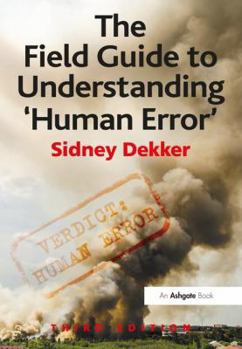The Field Guide to Understanding 'Human Error'
Select Format
Select Condition 
Book Overview
This title was first published in 2002: This field guide assesses two views of human error - the old view, in which human error becomes the cause of an incident or accident, or the new view, in which... This description may be from another edition of this product.
Format:Paperback
Language:English
ISBN:1472439058
ISBN13:9781472439055
Release Date:December 2014
Publisher:CRC Press
Length:248 Pages
Weight:0.95 lbs.
Dimensions:0.5" x 6.0" x 9.0"
Customer Reviews
5 ratings
Top 5 Human Factors Recommended Reading
Published by Thriftbooks.com User , 15 years ago
Mr Dekker's books should be required reading for all accountable executives in high reliability organizations. Over 30 years as a continuous system improvement advocate, I have recently developed a "Recommended Reading" list for those who are new to the field of human factors and system safety. Dekker now as 3 books on that list, with the recent release of "Just Culture." We live in the information age now; the only way to improve our lot is to share information for the purpose of continual learning. Dekker's approach points the way.
The Field Guide to Understanding Human Error
Published by Thriftbooks.com User , 15 years ago
Sidney Dekker has once again provided us with some very good examples from his line of work. Easy, informative and very catching. Simply a "must have" for every investigator or Human Factor-specialist who needs to communicate the intricacy of the Human Factors field to people around him or her. Mattias Eile 1st Submarine Flottila Royal Swedish Navy
The best guide to how to investigate error
Published by Thriftbooks.com User , 15 years ago
Essential reading for any safety investigator. An eye-opening way to transform your investigations by moving from the old-view to the new-view. I've used this book as a 'course book' for a seminar of 25 safety professionals to great effect. Plus there is a good guide to the role of a safety department too.
Back to the basics
Published by Thriftbooks.com User , 16 years ago
We all are extremely good to forecast the past. When this simple principle is applied to human error, it is very easy blaming the human operator. Dekker tries to put himself in the shoes of that human operator showing why an analysis that does not try to understand an event from that position is useless. There is a very hard criticism to different kind of positions taken by people that do not make that effort. If we try to make something as a "winzip on a summary" of the book, I think we could reach these conclusions: When we have to analyze an event, it should be useful starting with this hipothesis: "People are not usually dumb, people are not usually crazy and people have not usually chosen the day of a big accident to make self-killing." This starting point could be enough to avoid many of the practices fairly critiziced by Dekker.
Never look at human error the same way again!
Published by Thriftbooks.com User , 17 years ago
Over the past several years I have been going through a revolution in thought on incidents, accidents, and human error, thanks to Nancy Leveson of MIT, David Woods of Ohio State, and Sidney Dekker of Lund University in Sweden and others. Sidney Dekker's book, "The Field Guide to Human Error Investigations" continues the revolution. The book is divided into two parts: Part 1 of the book discusses the old views of human error and why they are flawed. For example, knowledge of the outcome of an accident can lead investigators to what is known as hindsight bias: the belief that the outcome was more predictable and recognizable, and critical cues missed by the participants were more apparent. Dekker also discusses how undefined, scientific-sounding words and phrases make for investigation and reports with little content. These, and many other discussions in Part 1 are part of the "bad apple" theme which states that if we just got rid of the "bad apples" in our organizations then our systems and organizations will be safe (until the next incident or accident happens!). Part 2 of the book examines investigating human error from the perspective that people at work generally make rational and safe decisions based on their understanding of their environment and generally do not consiously perform a known unsafe act. Often safety is one of a number of competing goals that people balance. Sometimes safety is reduced over time in a series of decisions that are reasonable at the time but in aggregate significantly increases coupling, complexity or safety margins. When an incident or accident occurs it is critical to understand the conditions and situation as the participants viewed it then, and to understand why the decisions and actions appeared correct and made sense to them, at that time. Only in this way will one get beyond the label of human error, gain insight on what led the people to take the action they did and what can be done. For those who subscribe to a "identify-blame-punish" approach to investigations this book will be unsatisfying. For those who want to go beyond the paradigm this book is well worrth the read.





